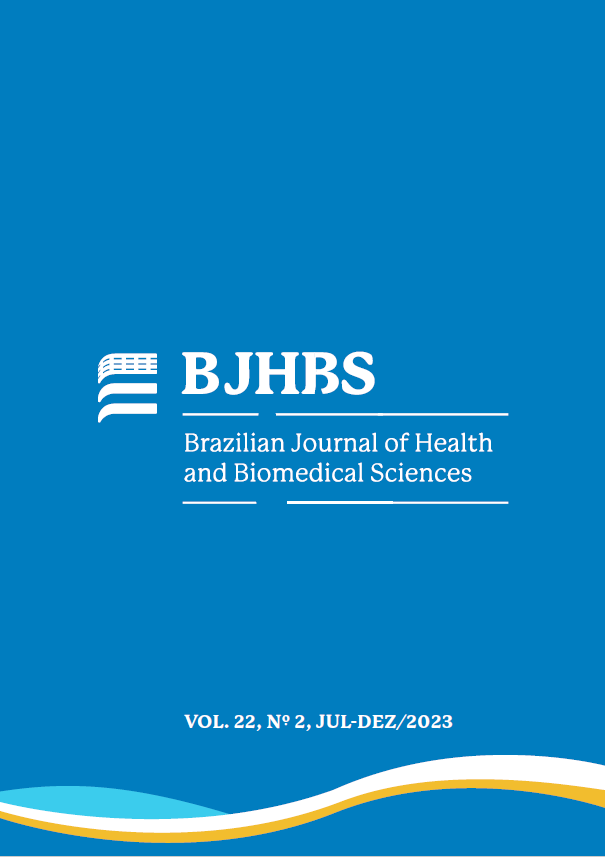Published 2023-11-01
Keywords
- Hamstrings,
- Flexibility,
- Joint position sense,
- Knee
How to Cite
Copyright (c) 2023 Brazilian Journal of Health and Biomedical Sciences

This work is licensed under a Creative Commons Attribution-NonCommercial-NoDerivatives 4.0 International License.
Abstract
Introduction: Different factors have been suggested to positively or negatively influence the knee joint position sense; however, the effect of hamstrings’ flexibility is poorly investigated. Objective: To investigate the influence of hamstrings’ flexibility on the knee joint position sense. Methods: Knee joint position sense of 31 adults was tested actively to extension for the range of 45º of knee flexion, in both the dominant and non-dominant limb. Hamstring’s flexibility was assessed through the sit and reach test, and considering these results, participants were divided into high and low flexibility categories. Intergroup analysis and the association between flexibility and repositioning errors were performed. Results: No significant differences were found between flexibility categories and repositioning accuracy. Similarly, no significant associations were found between flexibility and the repositioning errors (p>0.05). Conclusions: These results propose that hamstrings’ flexibility does not influence the knee repositioning accuracy, suggesting that both a lower or higher flexibility does not impair the knee joint position sense.
Metrics
References
- Rozzi S, Yuktanandana P, Pincivero D, Role of fatigue on proprioception and neuromuscular control. Proprioception and neuromuscular control in joint stability Champaign: IL: Hum p. 375-84.
- Craig JC, Rollman GB. Somesthesis. Annu Rev 1999;50(1):305-31. https://doi.org/10.1146/annurev.psych.50.1.305
- Gandevia S, Burke D. Does the nervous system depend on kinesthetic information to control natural limb movements? Behav Brain 1992;15:614-32. https://doi.org/10.1017/S0140525X0007254X
- Lattanzio PJ, Petrella RJ. Knee proprioception: a review of mechanisms, measurements, and implications of muscular fatigue. Orthopedics. 1998;21(4):463-71. https://doi.org/10.3928/0147-7447-19980401-19
- Proske U, Wise A, Gregory J. The role of muscle receptors in the detection of movements. Prog 2000;60(1):85-96. https://doi.org/10.1016/S0301-0082(99)00022-2
- Riemann BL, Lephart SM. The sensorimotor system, part I: the physiologic basis of functional joint stability. 2002;37(1):71-9.
- Lephart SM, Riemann BL, Fu FH. Introduction to the sensorimotor system. In: Lephart SM, Fu FH, editors. Proprioception and Neuromuscular Control in Joint Stability. Champaign: IL: Hum p. 37–51. https://www.ncbi.nlm.nih.gov/pmc/articles/PMC164311/pdf/attr_37_01_0071.pdf
- Proske U, Gandevia SC. The proprioceptive senses: their roles in signaling body shape, body position and movement, and muscle force. Physiol 2012;92(4):1651-97. https://doi.org/0.1152/physrev.00048.2011
- Azevedo J, Rodrigues S, Seixas A. The influence of sports practice, dominance and gender on the knee joint position sense. The Knee. 2021;28:117-23. https://doi.org/10.1016/j.knee.2020.11.013
- Ribeiro F, Oliveira J. Effect of physical exercise and age on knee joint position sense. Arch Gerontol 2010;51(1):64-7. https://doi.org/10.1016/j.archger.2009.07.006
- Salgado E, Ribeiro F, Oliveira J. Joint-position sense is altered by football pre-participation warm-up exercise and match induced fatigue. The Knee. 2015;22(3):243-8. https://doi.org/10.1016/j.knee.2014.10.002
- Marek SM, Cramer JT, Fincher AL, et Acute effects of static and proprioceptive neuromuscular facilitation stretching on muscle strength and power output. Athl 2005;40(2):94-103. https://www.ncbi.nlm.nih.gov/pmc/articles/PMC1150232/pdf/i1062-6050-40-2-94.pdf
- Nelson AG, Kokkonen J, Arnall DA. Acute muscle stretching inhibits muscle strength endurance performance. Strength Cond 2005;19(2):338-43. https://doi.org/10.1519/r-15894.1
- Bacurau RFP, Monteiro GA, Ugrinowitsch C, et Acute effect of a ballistic and a static stretching exercise bout on flexibility and maximal strength. Strength Cond 2009;23(1):304-8. https://doi.org/10.1519/JSC.0b013e3181874d55
- Akman M, Inal HS, Bayraktar B, et Is Hamstring Muscle Flexibility Effective on the Active Position Sense of the Knee Joints of the Elite Dancers? Int J Sports 2016;6(2):46-51. https://doi.org/10.5923/j.sports.20160602.05
- Porac C, Coren S. Lateral Preferences and Human Hehavior. New York: Springer-Verlag; 1981.
- Clark NC, Akins JS, Heebner NR, Reliability and measurement precision of concentric-to-isometric and eccentric-to-isometric knee active joint position sense tests in uninjured physically active adults. Phys Ther Sport. 2016;18:38-45. https://doi.org/10.1016/j.ptsp.2015.06.005
- Ribeiro F, Oliveira J. Efeito da fadiga muscular local na propriocepção do joelho. 2008;21(2):71-83. https://periodicos.pucpr.br/fisio/article/view/19095/18439
- Bennell K, Wee E, Crossley K, Effects of experimentally‐induced anterior knee pain on knee joint position sense in healthy individuals. Orthop 2005;23(1):46-53. https://doi.org/10.1016/j.orthres.2004.06.008
- Olsson L, Lund H, Henriksen M, Test–retest reliability of a knee joint position sense measurement method in sitting and prone position. Adv Med Med 2004;6(1):37-47. https://doi.org/10.1080/14038190310009894
- López-Miñarro PA, de Baranda Andújar PS, Rodríguez-García PL. A comparison of the sit-and-reach test and the back-saver sit-and-reach test in university students. Sports Sci 2009;8(1):116-22. https://www.ncbi.nlm.nih.gov/pmc/articles/PMC3737781/pdf/jssm-08-116.pdf
- Ribot-Ciscar E, Bergenheim M, Albert F, Proprioceptive population coding of limb position in humans. Exp Brain 2003;149(4):512-9. https://doi.org/10.1007/s00221-003-1384-x
- Gilhodes J, Roll J, Tardy-Gervet M. Perceptual and motor effects of agonist-antagonist muscle vibration in man. Exp Brain 1986;61(2):395-402. https://doi.org/10.1007/BF00239528
- Mayorga-Vega D, Merino-Marban R, Viciana J. Criterion-related validity of sit-and-reach tests for estimating hamstring and lumbar extensibility: a meta-analysis. Sports Sci 2014;13(1):1-14. https://www.ncbi.nlm.nih.gov/pmc/articles/PMC3918544/pdf/jssm-13-1.pdf
- Miyazaki M, Maeda S. Changes in hamstring flexibility and muscle strength during the menstrual cycle in healthy young females. J. Phys. Ther. Sci 2022;34(2):92-8. https://doi.org/10.1589/jpts.34.92
- Fouladi R, Rajabi R, Naseri N, Menstrual cycle and knee joint position sense in healthy female athletes. Knee Surg Sports Traumatol 2012;20(8):1647-52. https://doi.org/10.1007/s00167-011-1811-7





